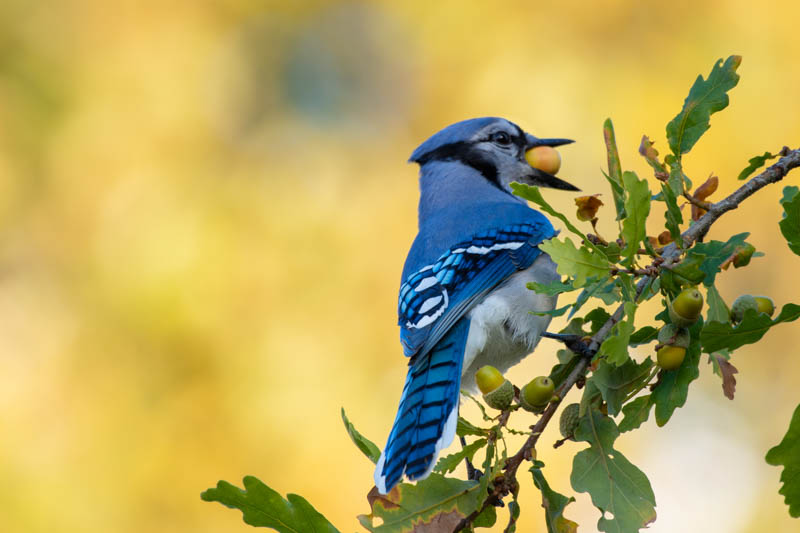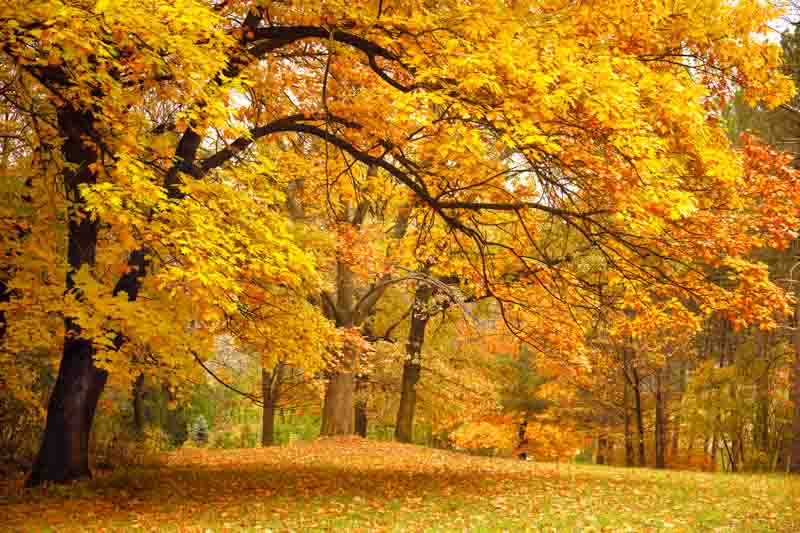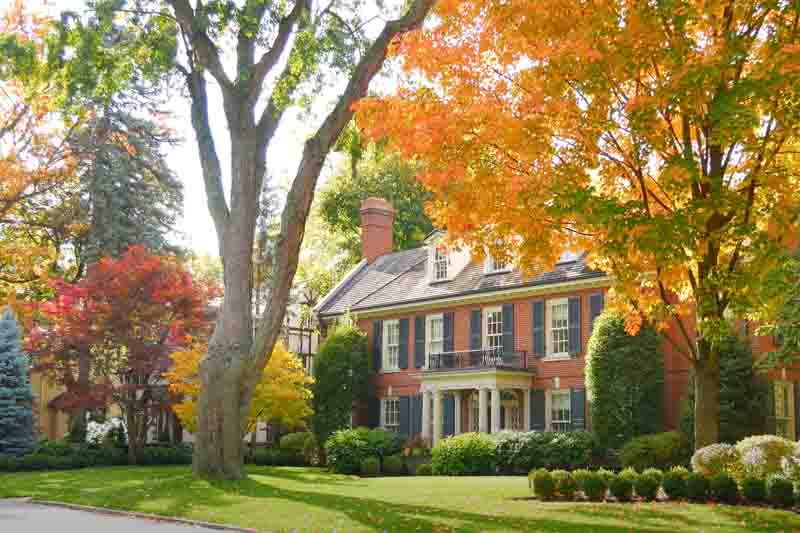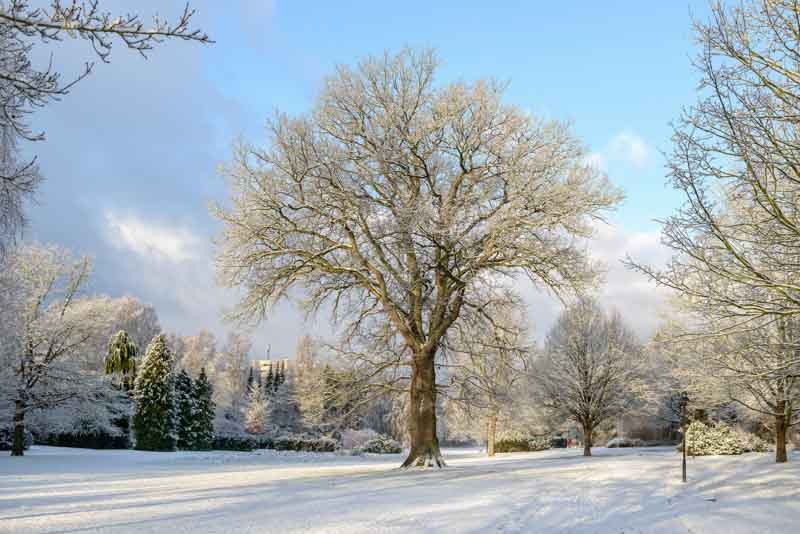Planting an oak tree enriches wildlife habitats, enhances carbon sequestration, improves air quality, bolsters soil health, and aids in water conservation
Oak trees, belonging to the genus Quercus, comprise over 600 species native to various regions across the Northern Hemisphere. These long-lived and hardy trees are revered for their ecological and aesthetic value. Oaks are found in diverse habitats, from dense forests to urban landscapes, and are celebrated for their unique characteristics, including varied leaf patterns, impressive acorns, and significant cultural symbolism.
Planting an oak tree brings numerous benefits, both environmental and aesthetic, making it a worthwhile addition to any landscape:
Oaks play a pivotal role in supporting wildlife, both as a habitat and as a crucial food source. Their significance in ecological systems is immense:
Acorns as a Food Source: An oak tree has the capacity to yield an astonishing three million acorns in his lifetime. Acorns are a key food item for a wide array of wildlife. Species such as deer, squirrels, and various birds heavily rely on these nuts for their nutritional value, especially during the winter months when other food sources are scarce. The high fat content in acorns provides essential energy to these animals.
Habitat for Birds: Oaks offer an ideal habitat for numerous bird species. Birds like woodpeckers find food in the insects that live in the bark, and others, such as owls and jays, use the sturdy branches for nesting. The complex structure of an oak tree, including its leaves, branches, and cavities, offers shelter and breeding sites for various bird species.
Did you know that oaks and jays share a mutually beneficial relationship? Jays feed on the nutritious acorns, which are a staple in their diet, and in return, these birds play a crucial role in oak dispersal. By caching acorns in the ground for later consumption, jays inadvertently aid in the germination and spread of new oak trees.

Blue jay bird feeding on the nutritious acorns of an oak tree.
Support for Insects: Oaks host a diverse range of insect life. Caterpillars of many butterfly and moth species feed on oak leaves, playing a crucial role in the food chain. In turn, these insects provide a food source for birds, particularly during the breeding season when birds are raising their young. Oak trees support over 800 caterpillar species in the United States and are host plants for over 500 species of butterflies, including the Striped Hairstreak, Banded Hairstreak, Edwards Hairstreak, Red Banded Hairstreak, White M Hairstreak, Mourning Cloak, and Horace’s Duskywing.
Mammal Habitat: Larger mammals, including squirrels and chipmunks, not only feed on acorns but also use oaks for shelter. Tree hollows in older oaks serve as nesting and resting places for these animals.

Baby Raccoon with Head and One Paw Sticking out of a Hole in an Oak Tree
Oaks significantly contribute to soil health and water conservation, playing a vital role in environmental sustainability:
Soil Enrichment: A mature oak tree can drop as many as 700,000 leaves each year. The resulting leaf litter decomposes into the soil, enriching it with organic matter. This process not only improves soil fertility by adding essential nutrients but also enhances soil structure, which aids in water retention and aeration. The decomposition of oak leaves also supports a myriad of microorganisms vital for a healthy soil ecosystem.
Erosion Control: Oak trees, with their extensive and deep root systems, are excellent at stabilizing soil. They prevent erosion, particularly in areas prone to heavy rain or wind. Their roots hold the soil together, reducing the loss of topsoil and maintaining the health of the land.
Water Conservation and Quality: Oaks play a role in water conservation. Their roots help maintain the water table and reduce runoff by allowing water to percolate more effectively into the ground. This not only conserves water but also improves water quality by filtering pollutants.
Shade and Temperature Regulation: The large canopy of oak trees provides significant shade, reducing ground moisture’s evaporation. This shade also keeps the soil and the surrounding environment cooler, further reducing water loss and helping conserve soil moisture.
Habitat for Water-Dependent Species: Oaks near water bodies like rivers and lakes provide a habitat for various water-dependent species. Their presence contributes to maintaining the ecological balance of these aquatic ecosystems.
Flood Mitigation: In floodplain areas, oaks can help mitigate the impact of flooding. Their roots absorb excess water, reducing the intensity of floods and preventing soil from washing away.

The leaf litter from oak trees decomposes into the soil, enriching it with organic matter
Oaks play a crucial role in carbon sequestration, a natural process of capturing and storing atmospheric carbon dioxide, which is key in mitigating the impacts of climate change. Oaks, with their large size and long lifespan, are particularly effective at this.
Large Biomass: Oaks grow to be substantial in size, both above and below ground. This large biomass means they can absorb and store a significant amount of carbon over their lifetimes. As they photosynthesize, they take in carbon dioxide from the air, using the carbon to grow and releasing oxygen back into the atmosphere.
Longevity: Oaks are known for their long lives, often living for hundreds of years. This extended lifespan allows them to sequester carbon for a longer period compared to shorter-lived plants. The longer a tree lives, the more carbon it can store.
Leaf Litter and Soil Carbon: When oak leaves fall, they decompose and become part of the soil organic matter. This process not only enriches the soil but also stores carbon in the soil. Since oaks produce a lot of leaves, they contribute significantly to the carbon stored in forest soils.
Habitat for Other Carbon-absorbing Plants: Oaks often serve as keystone species in their ecosystems, providing the necessary conditions for other plants to thrive. These plants, in turn, also capture and store carbon, amplifying the overall carbon sequestration effect of an oak-dominated area.
A Few Examples of Oak Species Excelling in Carbon Absorption:
Red Oak (Quercus rubra): This fast-growing species absorbs carbon quickly during its growth. It can absorb up to 20,000 pounds of carbon dioxide every 20 years. Its ability to thrive in diverse environments, including urban areas, makes it an important player in urban carbon sequestration, helping to offset the carbon footprint of cities.
Live Oak (Quercus virginiana): As an evergreen oak, the Live Oak continues to photosynthesize and sequester carbon year-round, unlike deciduous trees that lose their leaves in winter. This makes it an invaluable carbon sink in the regions it populates. A mature Live Oak can absorb up to 14,000 pounds of carbon dioxide in 25 years.
English Oak (Quercus robur): Common in Europe, the English Oak has been a significant part of reforestation efforts. Its widespread planting and long lifespan contribute to long-term carbon storage, playing a role in Europe’s efforts to combat climate change. An English Oak can absorb 38,000 pounds of carbon dioxide during its life.
Red Oak – Quercus rubra
Oak trees make a significant contribution to improving air quality, a benefit that is crucial in both urban and rural environments:
Pollutant Filtration: like other trees, Oaks act as natural air filters. Their leaves and bark absorb pollutants such as sulfur dioxide, nitrogen oxides, and particulate matter from the air. This filtration process is essential in urban areas where these pollutants are more concentrated due to vehicle emissions and industrial activities.
Oxygen Production: Through photosynthesis, oak trees take in carbon dioxide and release oxygen. A mature oak tree can produce enough oxygen in a season to support two people for a year. This oxygen production is vital for maintaining the air quality and the environment’s overall health.
Carbon Dioxide Reduction: Oaks play a role in reducing greenhouse gases in the atmosphere. By absorbing carbon dioxide, a major greenhouse gas, they help mitigate the impacts of climate change. This is especially significant in urban areas where carbon emissions are high.
Improving Respiratory Health: By filtering pollutants and producing oxygen, oak trees contribute to cleaner air, which is beneficial for human respiratory health. People living in areas with more trees often experience fewer respiratory problems.
Habitat for Air-Purifying Species: Oaks support a variety of plants and mosses that further purify the air, enhancing the overall air quality improvement.
McBaine Burr Oak – Quercus macrocarpa, estimated to be between 350 and 400 years old.
Oak trees are highly effective in providing shade and cooling, making them invaluable assets in both urban and natural landscapes:
Expansive Canopy: Many oak species, like the White Oak (Quercus alba) and the Bur Oak (Quercus macrocarpa), have large, spreading canopies. These broad canopies cover a substantial area, providing extensive shade. This shade is crucial in urban areas for reducing the heat island effect, where concrete and asphalt surfaces can significantly increase temperatures.
Cooling Effect: The shade cast by oak trees lowers surface and air temperatures beneath them. This natural cooling effect can make a noticeable difference in the comfort level of both outdoor and indoor environments, especially during hot summer months.
Reduced Energy Use: By providing natural cooling, oak trees can reduce the need for air conditioning in nearby homes and buildings. This not only leads to lower energy consumption but also decreases greenhouse gas emissions associated with electricity production.
Improved Outdoor Comfort: The shade from oak trees creates a more comfortable and inviting outdoor environment. Parks, gardens, and streets lined with oaks become pleasant areas for recreation and relaxation, encouraging outdoor activities.
Microclimate Regulation: On a larger scale, groups of oak trees can help regulate the microclimate of an area. They can maintain cooler local temperatures, which is beneficial for both humans and the ecosystem, particularly in mitigating the impacts of climate change.
Reduced Soil Temperature: The shade from oaks also helps in keeping the soil temperature cooler. This can improve soil moisture retention, benefiting other plants growing near or under these trees.
Shade provided by the large canopy of a Live Oak (Quercus virginiana) in Forsyth Park, Savannah, Georgia, USA
Oak trees can effectively function as natural sound barriers, contributing to noise reduction in various environments:
Dense Foliage and Thick Bark: Oaks, with their dense foliage and thick bark, can absorb and deflect sound waves. This characteristic makes them particularly effective in dampening noise pollution. The structure of their leaves and branches helps to break up and diffuse sound waves, reducing the impact of noise from traffic, industrial activities, or urban bustle.
Large Canopies Provide Wide Coverage: Many oak species, such as the Bur Oak (Quercus macrocarpa) or Red Oak (Quercus rubra), have wide, expansive canopies. This extensive coverage means a broader area can benefit from the sound-dampening effects of these trees. In urban and suburban settings, where noise pollution is a common issue, strategically planted oaks can significantly reduce the intrusion of unwanted sounds.
Creating Tranquil Spaces: Beyond their physical ability to reduce noise, the presence of oak trees can create a sense of tranquility and natural serenity. This psychological effect can make the perceived level of noise seem lower, contributing to a more peaceful environment.
Use in Landscaping for Noise Reduction: Oaks are often used in landscaping specifically for their sound barrier properties. Planting oaks along highways, around residential areas, or near commercial properties can help to create a buffer zone, reducing the penetration of noise into quieter spaces.
Enhancing Urban Environments: In cities, where noise pollution is a significant concern, oak trees can play a crucial role. By providing a natural barrier to sound, they enhance the quality of life for residents and contribute to the creation of more livable urban spaces.

Oak trees are renowned for their majestic beauty, adding a unique and commanding presence to any landscape:
Stately Appearance: Oaks, with their impressive size and grandeur, bring a sense of majesty to their surroundings. Species like the White Oak (Quercus alba) and the Red Oak (Quercus rubra) can grow to be quite large, creating a dominant and visually striking feature in any landscape.
Seasonal Beauty: Throughout the seasons, oaks display a spectacular array of colors and textures. In the spring, new leaves emerge, often with a delicate hue. In the fall, oak foliage turns into brilliant shades of red, orange, and yellow, providing a stunning display of autumnal color.
Unique Silhouettes: The distinctive shapes and silhouettes of oak trees, particularly in winter when they shed their leaves, add architectural interest to the landscape. The rugged outline of an oak’s branches against a winter sky can be quite breathtaking.
English Oak – Quercus robur adding architectural interest to the landscape in the winter
Varied Species, Varied Aesthetics: The diversity among oak species means a variety of aesthetic contributions to landscapes. For instance, the Columnar English Oak (Quercus robur ‘Fastigiata’) presents a tall, slender silhouette, ideal for narrow urban spaces. In contrast, the Bur Oak (Quercus macrocarpa) features a broad, spreading canopy with robust branches, offering a strikingly different visual impact. These contrasting forms – the elegant verticality of the Columnar English Oak and the majestic, wide spread of the Bur Oak – exemplify the wide-ranging silhouettes oaks can provide to enhance diverse landscapes.
Cultural and Historical Significance: Oaks have been revered throughout history, adding not just physical beauty but also a sense of continuity and connection to the past. They are often planted in parks and gardens for their symbolic value and historical importance.
Landscaping Versatility: Whether in a sprawling countryside, a suburban park, or an urban street, oaks are incredibly versatile in landscaping. They can be used as focal points, for creating natural borders, or as part of a mixed woodland setting.
Cork oak tree (Quercus suber) in evening sun, Alentejo Portugal Europe
Planting an oak tree is a timeless gift to future generations. These majestic trees, with their remarkable longevity, grow to become symbols of strength and endurance. Each oak serves as a living legacy, offering ecological benefits like biodiversity support, air quality improvement, and carbon sequestration. As they mature, they provide educational and aesthetic value, creating a natural heritage and fostering emotional connections for generations to come. Planting an oak is not just cultivating a tree; it’s nurturing a future rich in natural beauty and ecological balance. Learn how to grow majestic oaks from tiny acorns.
Angel Oak Tree (Quercus virginiana), Charleston, South Carolina, USA. Estimated to be 400–500 years old.
Create a membership account to save your garden designs and to view them on any device.
Becoming a contributing member of Gardenia is easy and can be done in just a few minutes. If you provide us with your name, email address and the payment of a modest $25 annual membership fee, you will become a full member, enabling you to design and save up to 25 of your garden design ideas.
Join now and start creating your dream garden!
Create a membership account to save your garden designs and to view them on any device.
Becoming a contributing member of Gardenia is easy and can be done in just a few minutes. If you provide us with your name, email address and the payment of a modest $25 annual membership fee, you will become a full member, enabling you to design and save up to 25 of your garden design ideas.
Join now and start creating your dream garden!